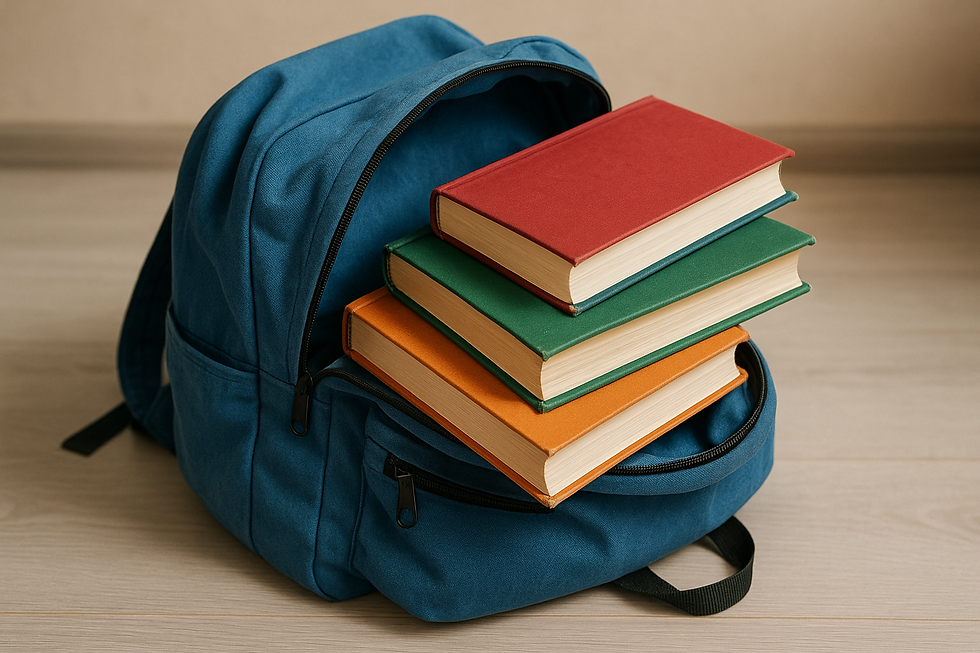Back to School For Parents
- Deborah Marks
- Oct 6
- 4 min read
Nervous System Prep, Not Just Stationery
Back to school doesn't start at the stationery aisle; it starts with your nervous system. New terms bring early alarms, lunch boxes, uniforms, permission slips, and a change to family rhythm. When the adults are steady, kids borrow that steadiness. This post gives you practical, body-based ways to help your household shift from holiday mode to school mode with more calm, connection, and confidence.
What “nervous system prep” really means
Think of the nervous system as your internal traffic controller. When it reads safety, our bodies settle, attention opens, and learning feels possible. When it reads threat, even small hurdles feel huge. Prep is not about being perfectly calm; it's about adding small signals of safety across the day, so your body and your child’s body can do hard things with support.
A simple rhythm to ease the transition
One week before the return. Start by nudging wake and sleep times toward school hours in 15 to 20-minute increments and add a gentle morning “anchor” that repeats daily. For example, open up the curtains, play one song, drink a glass of water, and add two minutes of movement. Build a micro-practice for you, not just the kids. This could look like three slow breaths while the kettle boils. It could also help to walk past the school or play at the oval for a few minutes, as exposure can reduce novelty. Pack the bag together and place it by the door the night before you need it, visible and ready.
The night before. Keep stimulation low, warmer coloured lights, and turn screens off a little earlier. Offer choices with boundaries such as “blue or white socks,” “banana or yoghurt,” which gives control without overwhelm. Name the plan out loud in a short and friendly way, “Wake, song, toast, shoes, car.” Your child’s brain relaxes when it hears what comes next.
The morning of. Protect the first five minutes after waking by avoiding rushing, giving eye contact, and giving a warm greeting to help the social brain come online. Eat something with protein and fibre, as blood sugar is the nervous system's fuel. Use a brief movement burst to discharge any jitters, like two minutes of star jumps, bear walks down the hall, or scooter to the car. If worries show up, acknowledge them first, then offer a next step: “Your tummy feels tight, that makes sense, let’s do three balloon breaths together, then we put on shoes.”
After school. Many kids need “nothing time” before questions. Offer a snack and a quiet corner, not a debrief. Watch for the “after-school restraint collapse,” the day’s effort spills out at home. Respond with co-regulation before correction, by sitting close, softening your voice, and naming one feeling and one need. This could sound like“Big feelings, small tank, snack and cuddle first.” Homework fits better after a reset.
Evening wind-down. Remember, predictable rituals soothe. The same order each night is more important than perfect timing. Try a quick body scan at tuck-in, “Can you feel your toes, your knees, your belly, your chest?” Add a gratitude or “rose and thorn” share to close the day with connection.
Support for sensitive or neurodivergent kids
If your child is autistic, ADHD, or highly sensitive, widen the runway. Use visual schedules, rehearse locker and classroom transitions, send a sensory “toolkit” in their bag like a chewy snack, noise-dampening ear muffs, a small fidget, and a printed calm-down card. Ask the teacher for a “safe base” person and place. Short, predictable supports reduce the load and protect confidence.
Parents, regulate first, then relate
Kids co-regulate with the adults they trust. Your steadiness matters more than the perfect plan. Quick check-ins with yourself can help: “Where am I, red, amber, or green?” “What is one thing I need, water, breath, or movement?” “What is one thing I can let go of today?” If mornings are fiery, you could try moving problem-solving to a calm time in the afternoon or evening. Repair is powerful. Repair can sound like, “That was a hard morning, I am sorry for snapping, I care about you, and we are a team.”
Micro-practices you can do anywhere
Three-count breathing. In through the nose for three, pause for one, out through the mouth for four. Do three rounds together in the car line.
Orienting. Look around and name five blue things, four round things, three soft things. This tells the brain, “I am safe in this place.”
Butterfly taps. Cross your arms over your chest and tap left, right, left, right for 20 to 30 seconds. A steady rhythm helps settle.
Name and notice. Tell yourself, "This is worry, not danger,” then take a small doable step.
Keep dot points light in your own home too, write two or three on a sticky note the night before, and stop there. Your brain prefers clarity over lengthy to-do lists.

When to seek extra support
If school worries last longer than a few weeks, if there are frequent stomach aches, panic, school refusal, or if mornings leave everyone exhausted, therapy can help. Short, practical support, including EMDR for anxiety, gives families tools to calm the body, make sense of triggers, and build confidence again.
If your family could use a steadier start to the term, I can help. I offer parent consults, child and teen sessions, and EMDR for anxiety and school stress in-person on the Gold Coast and online across Australia. Reach out today and let’s design a calm, doable plan for your household.



Comments